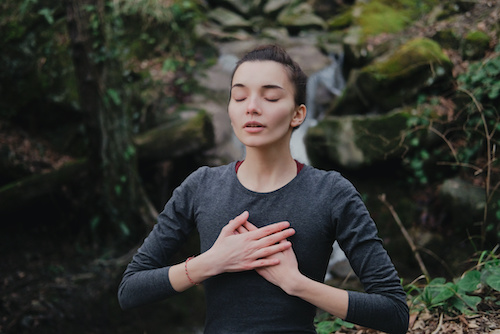There are many simple and effective breathing techniques for stress. Today you will learn and practice one of the most effective forms of intentional deep breathing. It defuses the stress feedback loop and teaches your brain and body to relax.
Taking a deep breath or two to relax, in and of itself, isn’t new. Many people take a few deep breaths when they’re feeling overcome by stress. The slogan “just breathe” appears on many things from billboards to t-shirts. Deep breathing is often referred to as “belly or diaphragmatic breathing”. And it is being used in many different mind-body therapies. But there is one basic problem with these breathing modification techniques – most people are not aware of their lung capacity. So, they fail to inhale or exhale completely. Why is this the case?
I’ve noticed that many people are not connected to the sensations and feedback from their bodies. This absence of body awareness may be a result of life experiences, such as severe trauma. Or it may be caused by living in a culture that uses a medical model where body and mind are considered separate rather than as one whole system. I have been teaching breathing techniques for several years now. And I noticed how surprised many people are at the discovery of their full breath capacity.
Not convinced?
Warm-Up: Here’s a fun exercise for a deep breathing technique.
Take a deep breath in and then measure the length of your slowest possible exhalation. Now do it again, but this time, measure the duration of your exhalation as you hum a single note as slowly as possible.
Did you find a difference?
We can get in touch with our breath with a simple yet effective form of deep breathing. This is intentional breathing. The emphasis is to allow the natural flow of the breath. You do this by inhaling from the top down and exhaling from the bottom up. Before you begin, there are a couple of things to remember:
Two things to keep in mind when practicing intentional breathing.
First, this is a practice. It may feel strange, awkward, or difficult at first. That is also normal when trying something that you’ve never attempted before. Be kind with yourself and see this as an exploration rather than something to be immediately mastered.
Second, if for any reason, you feel very uncomfortable or this doesn’t feel right to you, you can stop for a moment. It’s okay to take a break or stop the exercise and try again another time.
Practice Intentional Breathing Technique for Stress
1. Start by finding a comfortable position like sitting upright in a chair or lying on your back
Begin to observe your breath as it is right now. Notice where the breath flows – upper chest, lower belly, front, back, or sides. Avoid judging yourself on how you are breathing or attaching a story to it. Be like a scientist studying a cell under a microscope, see if you can notice the various details of your breath, one by one and make mental notes of them. Observe how you are breathing just as you are. It’s an interesting exercise. You may already notice that the act of observing your breath slows it down.
2. Place your hands on your chest and belly
Place your right hand on your breastbone (sternum) in the center of your chest. After place your left hand so that your thumb is below your navel. Continue to breathe in a normal way and notice whether you are breathing more into your right hand or into your left hand. See if you can resist the urge to change your breath or make it deeper. Breathe as naturally as you can and observe how it is to be in your body, breathing. How does it feel? What do you notice? Continue this for at least 10 breaths.
3. Breathe into your chest
Try breathing only into your right hand which is resting in the middle of your upper chest. Without forcing the breath, see how it feels to breathe into the space below your right hand. What do you notice? Can you slow your inhalation or is that difficult or uncomfortable? Only notice what happens. Keep observing this for 10–20 breaths. Then take a few deep inhalations and exhalations and go back to your natural breathing for a minute or so.
Begin to observe your breath as it is. Notice where the breath flows – upper chest, lower belly, front, back, or sides. As you do, avoid judging yourself on how you are breathing or attaching a story to it.
4. Breathe into your lower lungs
Next, try breathing only into your left hand that is resting on your abdomen. Without forcing the breath, see how it feels to breathe into the space below your left hand. What do you notice? Can you slow your inhalation or is that difficult or uncomfortable? Only notice what happens. Keep observing this for 10–20 breaths. Then take a few deep inhalations and exhalations and go back to your natural breathing for a minute or so.
5. Take half breaths into your chest and then your lower lungs
Now, try breathing half of your inhalation into your right hand. Pause for a second or two, and then breathe the rest into the space below your left hand and pause again. Then exhale from the bottom up, first releasing the air below your left hand. And then allow the exhalation to continue from below your left hand to below your right hand. Feel it traveling up and out, either through your nose or mouth. Now, continue to your next inhalation. First into the area beneath your right hand and then into the area beneath your left hand. Then exhale from the bottom up.
Can you slow your inhalation or is that difficult or uncomfortable?
How does it feel?
What do you notice? Keep observing this for 10–20 breaths. Then take a few deep inhalations and exhalations and go back to your natural breathing for a minute or so.
6. Take full breaths.
Finally, try breathing deep and full. Breathe all the way from top to bottom as you inhale and bottom to top as you exhale, without pausing. If possible, see if you can slow the exhalation so that it is longer than the inhalation. If you like, you can count 1, 2, 3, and so on to see which is longer: your inhalation or your exhalation. Keep doing this for 10–20 breaths. Then take a few big deep inhalations and exhalations and go back to your natural breathing for a minute or so.
7. Notice how you feel
Was the exercise simple or difficult?
Did this slow and full breathing seem usual to you?
How do you feel physically? Emotionally? Energetically?
If you like, write down your experience.
How Intentional Breathing Relieves Stress
This exercise activates your parasympathetic nervous system (PNS). That is when you relax, it slows down your heart and respiration rate and lowers your blood pressure. This allows your body to engage in regenerative and restorative functions. You may not relax right away, but most report feeling a sense of calm and less stress after this exercise.
Many people find that this intentional breathing exercise is very beneficial and informative. But it doesn’t always work for everyone. Some people find it difficult to focus on the breath when their brain is in a constant state of chatter. Someone reported that while the exercise was soothing, she struggled to keep her over-active mind in check. Her experience isn’t uncommon. There are many strategies to work with the mind in this situation. I found one that seems to work best for most people. You can attach your breath to a word or a phrase to keep the mind focused. For example, say “in” with the inhalation, and “out” with the exhalation. Pretty much any word or phrase can work to help focus the mind on the sensation of the breath.
The trick is to keep the word or phrase simple. The focus is still on the body sensation of breathing and not the thought, word, or story that describes it.
You may not relax right away, but many find it calming and notice a reduction of stress after this exercise. More breathing techniques you can find here.
Regardless of what works for you, intentional breathing takes practice. The good news is that it can be done anywhere. The more that you practice, the easier it becomes. Particularly at the beginning. It is best to practice intentional breathing at least a few times a day. Do this every day, in a quiet space and with all external distractions removed. You can do it whenever you find yourself sitting still for a few moments. It is much easier to learn a new skill while focusing on it, rather than trying to adopt it while multitasking.
Many people notice benefits from this practice right away. They feel more calm and relaxed after a few minutes of intentional breathing. After a while, you may notice a shift in your awareness of your breath. Or you may notice a tendency to have more deep and full breaths most of the time. This is the first step in defusing the stress feedback loop and teaching your brain and body to relax.
That’s it for today. If you wish to learn more techniques and tools to manage stress and anxiety join our Heal Yourself Community. Thanks.


